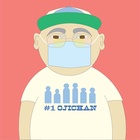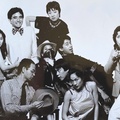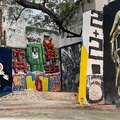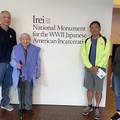I’ve been struggling with what more to say about the pandemic now known as the worst disaster of our lifetimes. I don’t ever remember feeling this fearful and uncertain about the future, particularly knowing as infection and death statistics grow with steady predictability, this highly contagious virus will most certainly infect someone I love, many of whom are in the dangerous high-risk age group.
In the midst of this immediate fear, I realized that most of us baby boomers and younger don’t have the first-hand experience of that other terrifying time in American history when our families were stripped of their freedom, forced to leave their homes, and hated because of their ethnicity. From our limited vantage point, we can’t possibly know how it felt to go through what our ancestors did more than 75 years ago, but I can’t help but think this pandemic, horrific as it is, still doesn’t compare to what they experienced in 1942.
To get a sense of the panic and distress of those times, one need only read a few first-hand accounts among many found in books like Duncan Williams’s American Sutra. Hisa Aoki wrote back then, “How long will we be forced to live like this? We have no rights; our freedom is strictly limited; and if we are only going to be fed, it is the same as a dog or a horse.” She went on, “I wonder if Japan has confined American noncombatants in horse stalls [with] women forced to use toilets with no doors.”
What’s striking about her account is the uncertainty about what is to come and how long these appalling circumstances are going to last. Though the unknowing feels oddly familiar today, how could what she describes even begin to compare with our own elective confinement in our homes faced only with the shortage of toilet paper?
It’s true that we have not yet experienced the worst of Covid-19 as the death numbers continue to rise. Except for those courageous members of the medical profession risking their lives to save others, it’s probably safe to say that those of us staying at home have only the economic loss of employment that undeniably hits some harder than others. As horrible as that can be for many, the economic devastation experienced by our ancestors who permanently lost much of their personal property, in addition to their livelihoods, is well in excess of the temporary financial losses faced by many today.
Despite the obvious differences, there are uncanny similarities between the wartime incarceration and the war against Covid. These days, we are faced with an eerie sense of emptiness on the once bustling streets of LA, while in May 1942, Mrs. Aoki writes of the “loneliness with a sunken feeling” of an empty Japantown. The difference is that as 110,000 of our families were being taken away, the emptiness in Little Tokyo was deeply personal. Our streets were the only ones condemned to silence as we became the face of the enemy.
Today, our Asian faces are being used once again as scapegoats for the crises. Driven by news that the virus originated in China, all of us—whether Chinese, Filipino, Japanese, Korean, etc.—are being singled out. More than 650 incidents of physical attacks and verbal harassment against Asian Americans have already been reported with more than 100 incidents per day currently being logged, according to a study conducted by SF State professor Russell Jeung. He says that occurrences have been reported that involve Asians being verbally abused, name-called, spat and coughed on, and even physically assaulted. These all-too familiar incidents are a constant reminder that the face of the enemy continues to exist.
Even more today, we are hopelessly short on “a leadership of integrity and compassion” (to quote historian Michi Nishiura Weglyn). Just as President Franklin D. Roosevelt, while admired by many, ignored his own experts’ reports that concluded Japanese Americans posed no threat in a war with Japan, the current administration has repeatedly ignored the advice of its own medical experts who warned of the severity of the virus. What’s more, the President succeeded in inflaming racist biases by insisting on calling it the “Chinese” virus early on in the daily White House briefings.
By far the most glaring example of the lack of compassion demonstrated by both FDR and Trump can be seen in the fact that 1,048 passengers aboard the cruise ship Zaandam were temporarily refused safe harbor in South Florida due to reports of four dead and more infected onboard. In 1939, FDR turned away the German ocean liner St. Louis headed to Miami carrying 937 Jews fleeing Nazi persecution, and more than a quarter of them subsequently died in the Holocaust.
The integrity and compassion missing in our current leadership is further demonstrated by the ongoing presence of detention centers—uncannily similar to the wartime incarceration camps—that operate despite repeated warnings of the life-threatening danger to immigrant families crowded in them. There are still 37,000 people in Immigration and Customs Enforcement (ICE) detention centers where social distancing, not to mention basic necessities such as soap and disinfectants, are nonexistent. Those of us who share a history of mass incarceration are quick to point out the grave inhumanity of such conditions.
My older sister recently reminded me to remember my grandmother’s words, “Gambare suru” (stay strong, stand firm) in the face of what we’re all going through. I’m sure my obachan used those words a lot while imprisoned with three of my siblings in a 60 x 120’ barrack room in the middle of the hot and dusty Arizona desert. Knowing how much more she had to bear, I hope I can summon some of her inner strength to help me through these troubling times.
As I do my daily YouTube yoga practice or go for a run along the open trails—with no barbed wire to keep me in—I think of her as I gaze out at the wide blue skies and realize just how much luckier I am.
* This article was slightly modified by the author for DiscoverNikkei. The original version was published in The Rafu Shimpo on April 4, 2020.
© 2020 Sharon Yamato








